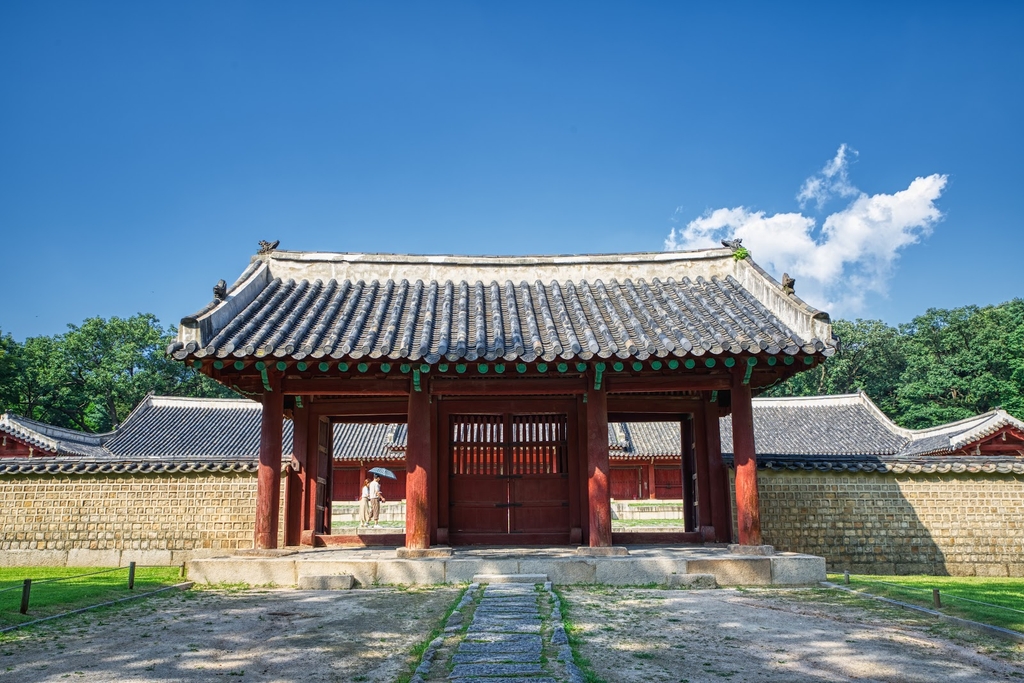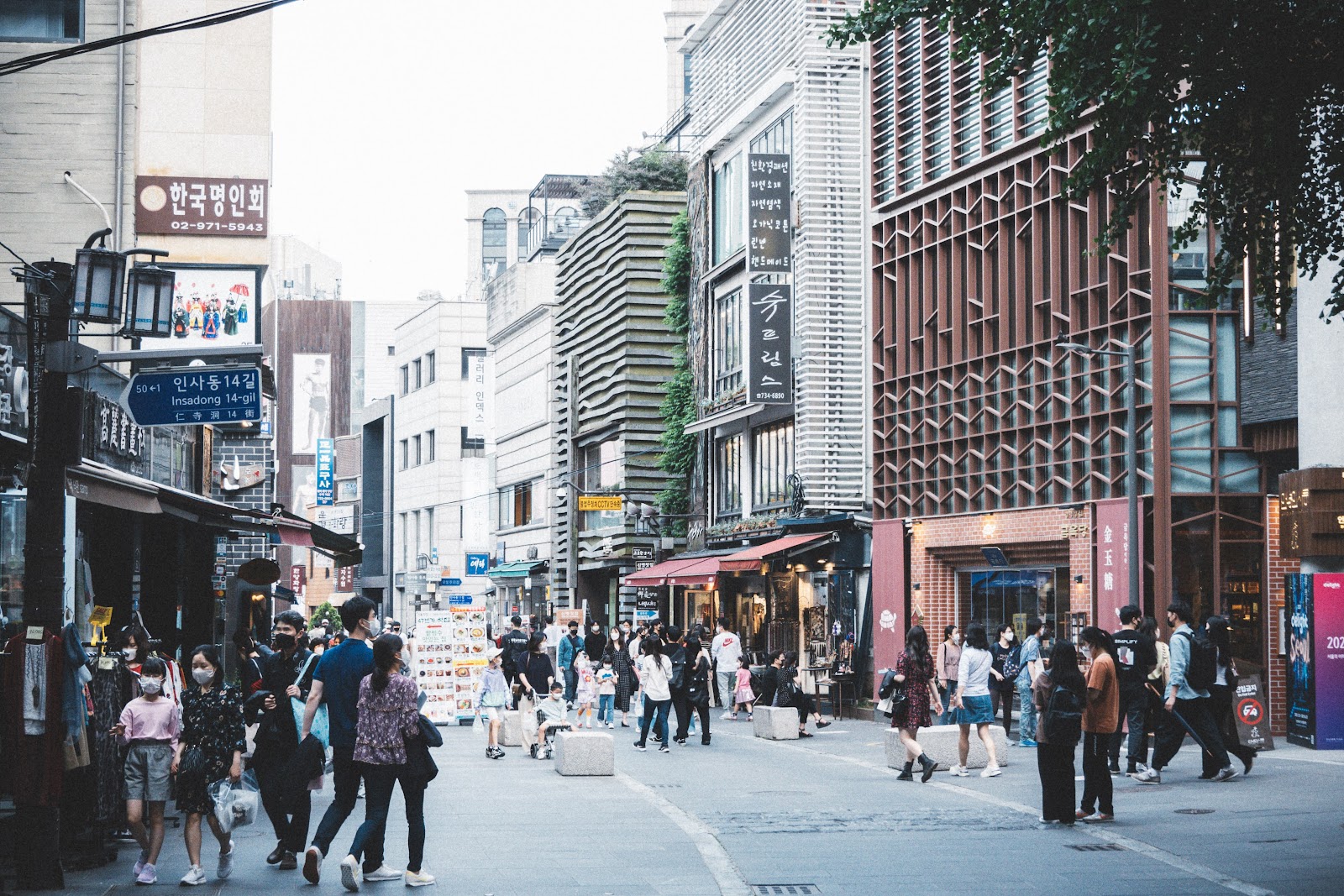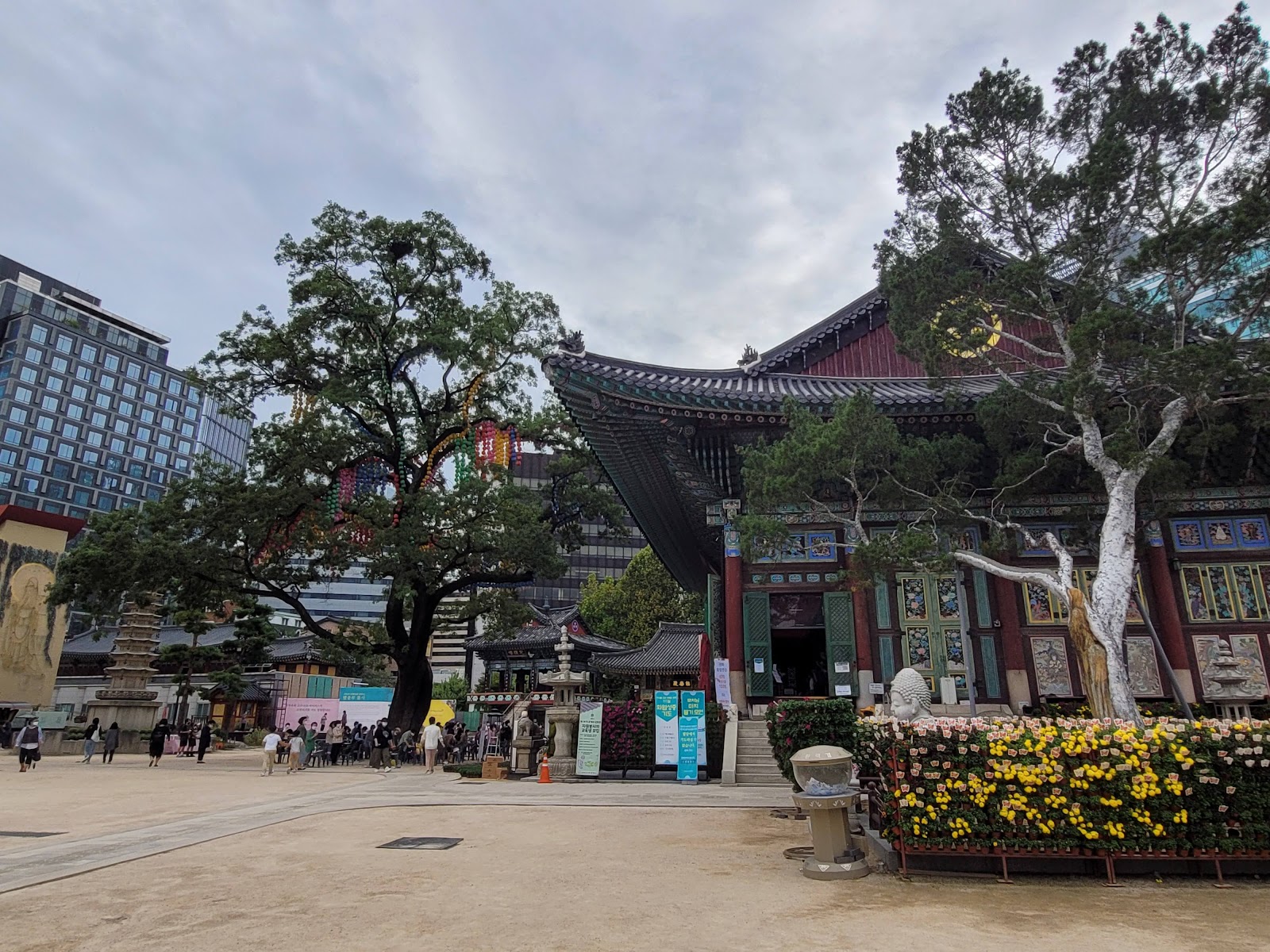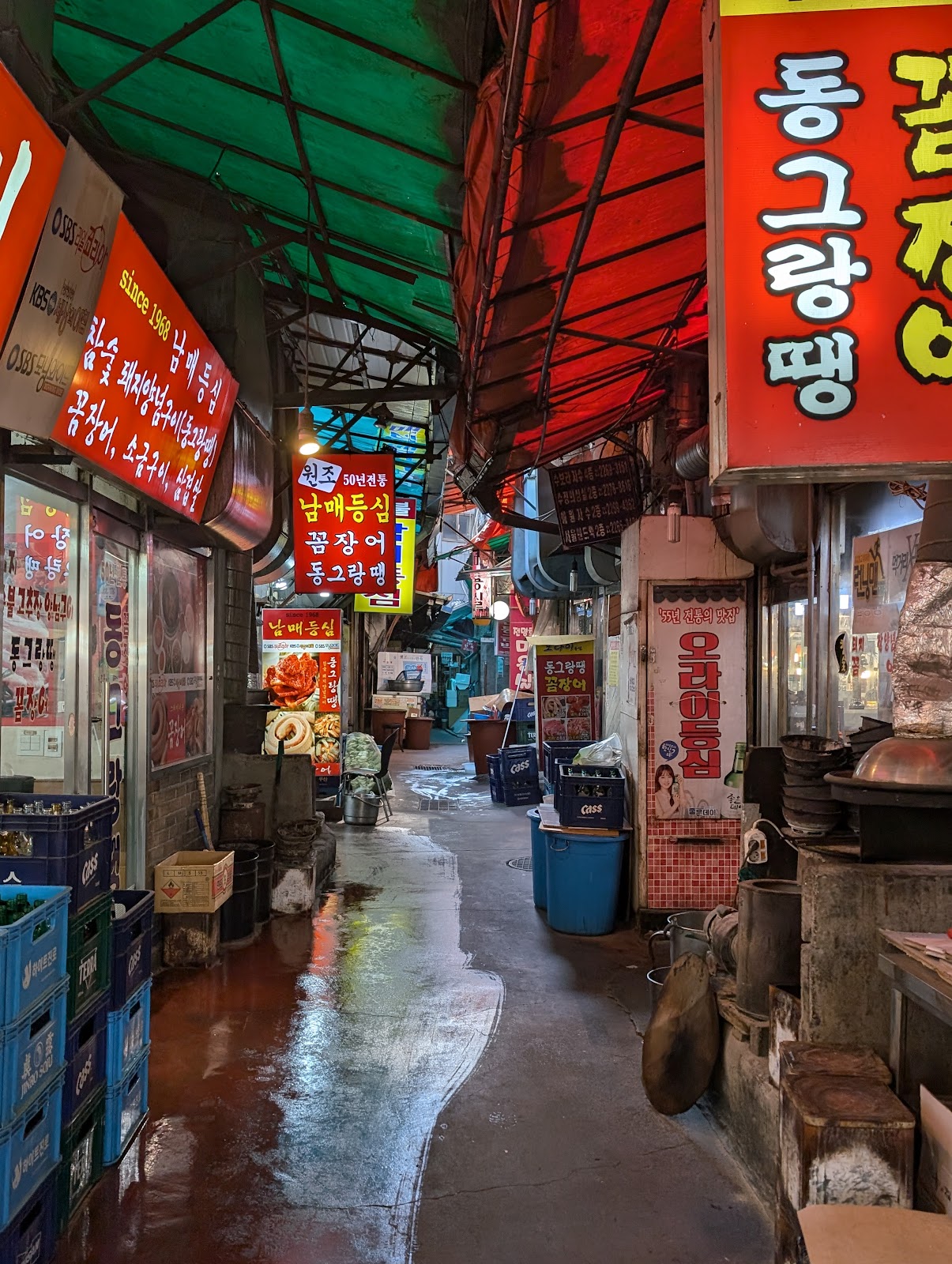Seoul's Royal and Cultural Journey
Experience the vibrant heart of Seoul on this free walking tour, unveiling the rich history and culture through stunning landmarks and hidden gems.
Time
3 Hours
Stops
9 Places
Distance
?
Gyeongbokgung Palace
Begin your tour at Gyeongbokgung Palace, the largest of the Five Grand Palaces built during the Joseon Dynasty, offering a glimpse into Korea's royal history.

Gyeongbokgung Palace (Source: Google Maps)
Gyeongbokgung Palace, constructed in 1395, is the largest of the Five Grand Palaces of the Joseon Dynasty. It served as the main royal palace and is a symbol of Korea's royal heritage. The palace reflects traditional Korean architecture with its elegant wooden structures and beautiful tiled roofs. Highlights include the iconic Gwanghwamun Gate, which stands as the main entrance, and the National Palace Museum of Korea located on the grounds, showcasing the royal artifacts and history. The palace is also home to the changing of the guard ceremony, a vibrant display of tradition that occurs regularly, drawing both locals and tourists alike. The surrounding gardens and the picturesque backdrop of the mountains provide an ideal setting for understanding Korea's historical significance.
National Folk Museum of Korea
Located within the grounds of Gyeongbokgung Palace, this museum provides an insightful look into the traditional life and culture of Korean people.

National Folk Museum of Korea (Source: Google Maps)
The National Folk Museum of Korea, situated within the grounds of Gyeongbokgung Palace, offers a comprehensive view of Korean life through the ages. Established in 1945, the museum houses a vast collection of artifacts that illustrate the daily lives, customs, and traditions of the Korean people. Its exhibitions are categorized into three main themes: 'The History of Korean Life,' 'The Life of the Korean People,' and 'The Korean Folk Culture.' Visitors can explore traditional clothing, tools, and household items that date back centuries. The museum's outdoor exhibition area features various traditional houses and structures, providing a tangible connection to Korea's cultural heritage. As a center for research and education, it plays a vital role in preserving the country’s folklore and traditions.
Bukchon Hanok Village
Just a short walk from the palace, Bukchon Hanok Village is a charming neighborhood filled with traditional Korean houses, known as hanoks, offering a picturesque view of Seoul's past.

Bukchon Hanok Village (Source: Google Maps)
Bukchon Hanok Village is a historic neighborhood that showcases traditional Korean houses known as hanoks. Nestled between Gyeongbokgung Palace and Changdeokgung Palace, the village dates back to the Joseon Dynasty and provides a glimpse into Korea's architectural past. The area is characterized by its narrow alleys and well-preserved hanoks, many of which are still inhabited by locals. Visitors can stroll through the village and admire the unique architectural features, including wooden beams, tile roofs, and courtyards that reflect the harmony with nature. Bukchon serves not only as a residential area but also as a cultural center, with galleries, tea houses, and workshops where traditional crafts are practiced. It is a living museum that offers insight into the lifestyle of the Joseon nobility and the enduring legacy of Korean culture.
Changdeokgung Palace
Renowned for its beautiful garden and harmonious architecture, Changdeokgung Palace is a UNESCO World Heritage Site and a testament to Korean aesthetics and design.

Changdeokgung Palace (Source: Google Maps)
Changdeokgung Palace, a UNESCO World Heritage Site, is renowned for its stunning architecture and beautiful gardens. Built in 1405, it served as a secondary palace for the Joseon Dynasty and is celebrated for its harmonious integration with the surrounding landscape. The palace complex features a rear garden known as Huwon, which was designed to reflect the natural beauty of Korea and includes scenic walking paths, ponds, and a variety of trees and flowers. The architecture of Changdeokgung exemplifies the principles of Korean aesthetics, emphasizing balance and tranquility. Visitors can explore the main throne hall, where important state affairs were conducted, and appreciate the intricate details of the buildings. The palace is a testament to the artistic and cultural achievements of the Joseon era, attracting visitors for its beauty and historical significance.
Jongmyo Shrine
This Confucian shrine, dedicated to the deceased kings and queens of the Joseon Dynasty, is one of the oldest preserved royal shrines in the world.

Jongmyo Shrine (Source: Google Maps)
Jongmyo Shrine is one of the oldest and most significant royal shrines in Korea, dedicated to the spirits of the deceased kings and queens of the Joseon Dynasty. Established in 1394, the shrine is an important site for Confucian rituals and ceremonies, reflecting the deep-rooted traditions of Korean spirituality and respect for ancestors. The architectural style of Jongmyo is characterized by its simplicity and harmony with nature, using natural materials that blend seamlessly into the surrounding landscape. The shrine houses tablets inscribed with the names of the royal family, and visitors can witness the ceremonial rites that take place during the Jongmyo Daeje, which is recognized as a UNESCO Intangible Cultural Heritage. Its historical and cultural significance makes Jongmyo Shrine a must-visit site for anyone interested in Korea's royal heritage.
Insadong Street
A vibrant neighborhood known for its traditional tea houses, art galleries, and antique shops, Insadong offers a perfect blend of modern and traditional Korean culture.

Insadong Street (Source: Google Maps)
Insadong Street is a vibrant cultural district in Seoul, known for its blend of traditional and contemporary Korean culture. This neighborhood is a hub for art, antiques, and traditional crafts, attracting both locals and tourists alike. The street is lined with tea houses, galleries, and shops selling handmade crafts, calligraphy, and traditional Korean souvenirs. Visitors can immerse themselves in the rich cultural experiences offered, such as tea ceremonies and art exhibitions. Insadong is also famous for its street food, providing a taste of authentic Korean cuisine. The area hosts various cultural events and festivals throughout the year, celebrating the arts and heritage of Korea. As a center of cultural exchange, Insadong embodies the spirit of Korea, making it a lively and enriching place to explore.
Jogyesa Temple
As the chief temple of the Jogye Order of Korean Buddhism, Jogyesa Temple provides a peaceful retreat in the heart of the city with its serene atmosphere and beautiful architecture.

Jogyesa Temple (Source: Google Maps)
Jogyesa Temple is the chief temple of the Jogye Order of Korean Buddhism, located in the heart of Seoul. Founded in the late 14th century, it serves as the center for Korean Zen Buddhism and is known for its serene atmosphere and stunning architecture. The temple features beautifully adorned halls and a tranquil courtyard, where visitors can experience the peacefulness of Buddhist practices. Notable elements include the large statue of the Buddha, intricate lanterns, and the vibrant colors of the temple's decorations, especially during the Lotus Lantern Festival. Jogyesa is also an important site for meditation and prayer, attracting practitioners and visitors seeking spiritual solace. The temple plays a significant role in preserving and promoting Korean Buddhist traditions, making it a key cultural landmark in Seoul.
Cheonggyecheon Stream
This urban renewal project transformed a neglected stream into a beautiful public space, offering a tranquil walking path amidst the bustling city.

Cheonggyecheon Stream (Source: Google Maps)
Cheonggyecheon Stream is an urban renewal project that transformed a neglected waterway into a beautiful public space in the heart of Seoul. Originally a natural stream, it was covered over in the 20th century but was restored in 2005, creating a vibrant linear park that stretches for several kilometers. The stream is lined with walking paths, art installations, and greenery, making it a popular spot for relaxation and leisure. Cheonggyecheon serves not only as an ecological restoration project but also as a cultural space, hosting various events and festivals throughout the year. The revitalization of the stream has enhanced the urban landscape, providing a tranquil oasis amidst the bustling city. It is a testament to Seoul's commitment to sustainable urban development and serves as a model for similar projects worldwide.
Gwangjang Market
End your tour at Gwangjang Market, one of the oldest traditional markets in Seoul, where you can explore a variety of street food and local delicacies.

Gwangjang Market (Source: Google Maps)
Gwangjang Market is one of the oldest traditional markets in Seoul, established in 1905. It is renowned for its vibrant atmosphere and wide variety of local delicacies, making it a must-visit for food lovers. The market features numerous stalls and vendors selling traditional Korean street food, including bindaetteok (mung bean pancakes), tteokbokki (spicy rice cakes), and a variety of pickled vegetables. Visitors can also find textiles, clothing, and handmade crafts, reflecting the rich cultural heritage of Korea. Gwangjang Market is not only a place to shop but also a cultural experience, where one can interact with local vendors and learn about traditional Korean culinary practices. The market embodies the spirit of community and commerce, providing a unique glimpse into the daily life of Seoul's residents.

Your travels, your rules.
Create your own Free Walking Tours.
Set your preferences, distances and anything you want to do or see.
Completely free, no payment required.